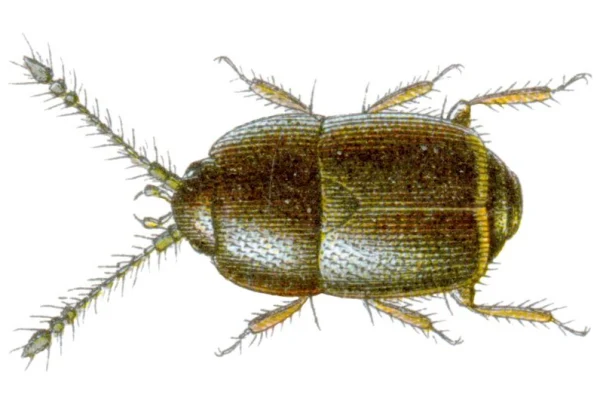Every fourth animal on Earth is a beetle. Yes, you read correctly! Those tiny marvels of nature make up the most massive order of insects on Earth, with an astounding range of forms, sizes, and colors. Each has a distinctively appealing quality, from the regal stag to the bright jewel and even the smallest beetles in nature. Owning one can even make you a millionaire! Therefore, we can’t emphasize enough how valuable these little bugs are.
But How Small Are The Smallest Ones?
The smallest beetles are less than a millimeter in size. Fascinating, no? And no wonder they cannot be spotted very easily out and about.
The smallest beetles among this interesting group possess a distinct fascination, stimulating our interest with their tiny size and remarkable adaptations.
Even the tiniest beetles are vital to many ecosystems. They are a great indicator of local conservation efforts and regional biodiversity because they show the biological continuity of vulnerable ecosystems like old-growth woods and chalk downlands, as well as the quality of freshwater.
The 10 smallest beetles in nature are highlighted in this article, displaying their amazing adaptations and ecological importance.
10 Smallest Beetles in Nature
1. Nanosella fungi
| Scientific Name | Nanosella fungi |
| Size | 0.25-0.35 mm |
| Color | Light to dark red-brown |
| Location | Eastern and southern United States. |
They are often associated with fungi and mosses in damp habitats. The smallest known ant beetle, Nanosella fungus, has a maximum length of only 0.25 mm and a weight of only 0.4 milligrams.
These beetles are well recognized for their unique appearance, which resembles ants in certain ways. They also have a fringe of hair on their bodies that aids in camouflage. These beetles keep themselves alive by associating with the spore tubes of polypore fungi.
2. Feather-winged (the smallest beetle)
| Scientific Name | Scydosella musawasensis |
| Size | 0.325 mm. |
| Color | Yellowish-brown |
| Location | Nicaragua |
The one making our list first must be a record holder. Scydosella musawasensis is the smallest free-living bug. The Feather-winged Beetles are delicate creatures named for their feathery hind wings, which are longer than their bodies.
With a record length of 0.325 mm. Native to Nicaragua, these beetles are often associated with fungi and are typically found in leaf litter.
3. Fringed Ant Beetle (Nymphister kronaueri):
| Scientific Name | Nymphister kronaueri |
| Size | 0.38 mm |
| Color | dark red brown |
| Location | Costa Rica |
The Fringed Ant Beetle’s name is pretty catchy. Does it suggest an ant and a beetle? Yes. Nymphister kronaueri was found in symbiont association with army ants.
As the name suggests, they have unique fringed structures on their bodies that help them attach to the abdomens of army ants.
This association grants them access to the ants’ food and shelter. In turn, they clean and groom the hardworking ants. Another fact worth noticing is that their activities are largely nocturnal; they don’t accompany the ants in daylight.
4. Micridium: the tiny beetle
| Scientific name | Millidium minutissimum |
| Size | 0.58-0.63 mm. |
| Color | Pale brown |
| Location | Central and Northern Europe |
The Agyrtidae family comprises numerous small beetle species, with some measuring as small as 0.45 mm. These beetles typically live in soil, leaf litter, and decaying organic matter.
Adults thrive in rotting wood and old oak bark in UK records when they are believed to be associated with Laetiporus sulfurous mycelia.
Though adults have been observed throughout the entire continent all year, their abundance surges in May and June and then again in August and September.
5. Pteryx suturalis
| Scientific Name | Pteryx suturalis |
| Size | 0.75-0.85 mm |
| Color | dark red brown |
| Location | California, USA |
They inhabit wooded areas around mammals’ and birds’ nests, as well as in Wood ant nest materials, throughout northern Europe.
Adult individuals of Pteryx suturalis are present year-round, active from February to November, in most numbers during June and July, and again in the late summer.
Both adults and larvae feed on fungi’s spores and/or hyphae, and larvae develop throughout the summer to give rise to a new generation in late summer or early autumn.
This interesting lifecycle is the reason why beetles and their adaptations to the environment fascinate us. Adults typically appear in groups and may coexist with other family members. They are active throughout most of the year, except for the coldest winter months.
6. Baeocrara from Featherwing Beetle Family
| Scientific name | Baeocrara felis |
| Size | 0.5-1 mm |
| Color | dark brown to black |
| Location | Czech Republic |
One unique member of the featherwing beetle family is Baeocrara. Unique because of the complex design of its flight wings, which have a lengthy fringe of hair along their edges.
The Baeocrara beetle made it onto the list for their tiny bodies, measuring between 1 and 0.5 mm, and they are members of the Ptiliidae family.
We find them thriving primarily in hollow oak stumps, over rotting wood, animal waste, and plant debris. This tiny mate eats fungus spores for food. Baeocrara is one of the least well-known Coleoptera groups.
7. Hydraenidae beetles (Minute Moss Beetles)
| Scientific name | Hydraena pulchella |
| Size | <0.5 to 3.3 mm. |
| Color | dark brown to blackish |
| Location | Worldwide distribution, mostly in Southern Hemisphere |
Aquatic, tiny, and highly adaptive insects, aka Minute Moss Beetles. The larvae and adults in this category feed on algae, bacteria, protozoa, and detritus. also grazing on wet stones, sand grains, and plant matter.
Members of the Hydraenidae family mostly look identical. Although there are around 1300 species in 41 genera in this family.
The sizes may also greatly vary. But the tiniest one here is Hydraena pulchella, measuring less than 1mm in length. This tiny fellow is found in freshwater habitats throughout Europe and Asia.
8. Acrotrichis grandicollis

| Scientific Name | Acrotrichis grandicollis |
| Size | 0.9-1.0 mm. |
| Color | dark brown/black |
| Location | North & Central America |
Like most other members of the Ptiliidae family, we find them in leaf litter, mammal nests, dung, and decaying fungi.
The broadly oval and distinctly constricted body with a dorsal black surface having a distinct metallic reflection makes it unique in appearance.
However, they are mostly present in areas with other ptilids, which makes them harder to spot and identify.
9. Ptomaphagus hirtus
| Scientific Name | Ptomaphagus hirtus |
| Size | 1.5-2.5 mm |
| Color | Yellow to Light brown |
| Location | North America |
At about 1.5 mm, Ptomaphagus hirtus is one of the smallest representatives of the Leiodidae family. We predominantly find them in forests and wooded areas, where they feed on decaying organic matter.
Like the other beetles in the family, it has a compact and rounded body shape. Also, the species name “hirtus” specifies that they have characteristic hairs or bristles on the body.
10. Ptinella minuta
| Scientific Name | Ptinella minuta |
| Size | 1.5-2 mm |
| Color | Light red-brown to black |
| Location | Tropical regions worldwide |
The Ptinella genus of beetles belongs to the family Ptiliidae. We commonly call them feather-winged beetles due to their distinctive long and narrow hind wings and shorter forewings. Much like the others, they are also often associated with decaying plant material.
Let’s Know A Little More About The Feather-wing Beetles
Given their numerous appearances on this list, feather-wing beetles deserve special attention.
The smallest insects in nature—even the tiniest ever observed—are members of the Ptiliidae family, typically known as the featherwing beetles. They can be found around the world in both tropical and temperate climates. Although they are abundant, not all of them are described and identified. Credit goes to their minute sizes that they often miss the spotlight of entomologists.
Not only their size but their mysterious habits also make them hard to spot. Though they are not harmful, featherwing beetles are particularly fascinating from an ecological and evolutionary perspective due to their unique adaptations and survival even after the size.
The smallest of all beetles belong in this family; when fully grown, they only measure between 0.3 and 4.0 mm in length. Scydosella musawasensis and Nanosella fungus, the smallest ever recorded, are members of this same family, also beholding the reputation of the tiniest known free-living insects.
Conclusion
The world of beetles is truly astonishing, with a wide array of sizes, colors, and other variations. And the above-listed top 10 smallest beetles showcase the fascinating adaptations that enable them to thrive in their respective habitats. Despite their tiny bodies, these beetles play crucial roles in various ecosystems, contributing to the intricate balance of nature.
Frequently Asked Questions
Q1. How small is the smallest beetle ever existing?
Ans. The smallest beetles, Nanosella fungus and Scydosella musawasensis, measure only between 0.25 and 0.325 mm, practically the tiniest free-living, non-parasitic insect.
Q2. What is the smallest insect?
Ans. Dicopomorpha echmepterygis, a parasitic wasp, is the tiniest known adult insect. With the common name – fairyflies, the males are barely 0.127 mm long, blind, and lacking wings.
Q3. Are beetles useful to humans?
Ans. The ecosystem and humanity both benefit from beetles! Beetles are beneficial to vegetation and are a farmer’s friend.
Beetles consume waste, rotting timber, and carcasses to produce soil suitable for plants to flourish on. Additionally, through predation, they maintain the equilibrium of other insect populations and pollinate flowers.
Also Read:

Anjali Prasad, a B. Pharm. graduate who works as a content writer for HowItSee, is based in Delhi. Except for her, not many people take the typical road from healthcare to writing. Her love of writing stemmed from her involvement in the college literature society and her early journaling at the age of 7. Hence, the love of learning and the spirit of exploration are what drew her to this career. You can find her on common social media like Instagram.
